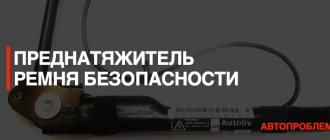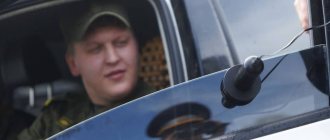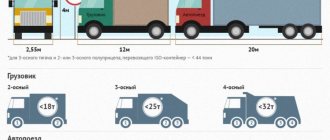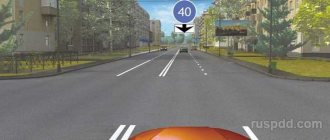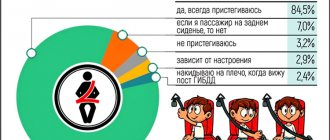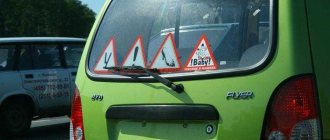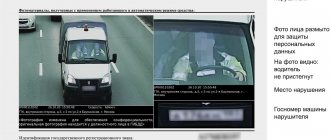Traffic regulations on tinting:
In clause 7.3. “The list of faults and conditions under which the operation of the vehicle is prohibited” (Appendix to the Traffic Rules) states that the operation of the vehicle is prohibited if:
Additional objects have been installed or coatings have been applied that restrict visibility from the driver's seat.
Note. Transparent colored films can be attached to the top of the windshield of cars and buses. It is allowed to use tinted glass (except for mirror glass), the light transmission of which complies with GOST 5727-88. It is allowed to use curtains on the windows of tourist buses, as well as blinds and curtains on the rear windows of passenger cars if there are external rear-view mirrors on both sides.
Tinting and law from January 1, 2021
On September 23, 2010, amendments to Article 12.5 of the Code of the Russian Federation on Administrative Offenses came into force regarding increasing the responsibility of drivers for driving a vehicle with glass installed (including those covered with transparent colored films), the light transmission of which does not meet the requirements of technical regulations. on the safety of wheeled vehicles.
In accordance with amendment No. 3 to GOST 5727-88 “Safety glass for land transport”, the light transmittance of vehicle windshields must be at least 75%, front door glass - at least 70%, other glass - is not standardized. Windshields painted in the paste and tinted must not distort the correct perception of white, yellow, red, green and blue.
Athermal tinting meets all GOST requirements.
- Note 1: A light-protective strip no more than 15 centimeters wide can be made on the windshield.
- Note 2: In accordance with the above-mentioned documents, it is allowed to have a completely darkened rear window, provided that the car or other vehicle is equipped with rear-view mirrors on both sides (both right and left).
It is worth paying attention to the fact that it is now possible to tint car windows yourself, either by spraying or by covering the glass with films both outside and inside the car. Resolution No. 353, supplementing GOST, now allows any method of tinting, the only condition is that light transmission must be within the permitted limits. It should be noted that although mirror tinting is not directly prohibited by GOST, the attitude of traffic police officers towards it is “especially attentive”, since the traffic rules contain a clause prohibiting the use of mirror glass.
The technique for checking glass for darkness is also set out in GOST. In particular, for this purpose, the traffic police use special devices - taumeters, the most common of which is called “Blik”.
- GOST 27902 88 defines the rules for measuring the level of light transmission of glass on the street using a special device. The air temperature should vary from +15 to +25 degrees, the air humidity should be from 40% to 80%, and the air pressure should be from 86 to 106 kPa.
- In practice, this means that in addition to the main device for measuring the level of light transmission of glass, the traffic police officer must have a certified thermometer, barometer and air moisture meter. If there were none, you can safely write down in the protocol “I do not agree with the violation,” explaining that the requirements of GOST 27902 88 were not met during the inspection.
If you are interested in car tinting, then you can contact our specialists for a consultation.
I. Excerpt from traffic rules:
List of malfunctions and conditions under which the operation of vehicles is prohibited: 7. Other structural elements 7.3. Additional items have been installed or coatings have been applied that limit visibility from the driver's seat, impair the transparency of the glass, and pose a risk of injury to road users.
Note. Transparent colored films can be attached to the top of the windshield of cars and buses. It is allowed to use tinted industrial glass (except for mirror glass), the light transmission of which complies with the requirements of GOST No. 5727-88. It is allowed to use curtains on bus windows, as well as blinds and curtains on the rear windows of passenger cars if there are external rear-view mirrors on both sides.
II. GOST 5727-88. “The glass is safe for ground transport. General technical conditions" "The light transmission of windshields of vehicles and trams must be at least 75%, other glass - at least 70%." And an amendment made in 1992, “glasses that do not affect the driver’s view may have a light transmittance of less than 70%, with no lower limit. If there are working side mirrors, the glass of the rear hemisphere of the car can have any light transmission.”
III. Change N2 to GOST 5727-88 “Safety glass for land transport” - adopted by the State Standard of the Russian Federation, in accordance with it, the light transmission of rear and side windows (except for front door windows) is allowed up to 60% versus 70% previously. For windshields and front side windows, the old requirements remain - at least 75% and 70%, respectively. The changes took effect on July 1, 1999.
IV. CHANGE N 3 to GOST 5727-88 “Safety glass for land transport. General technical conditions"
Date of introduction 2002-01-01 ACCEPTED AND ENTERED INTO EFFECT by Resolution of the State Standard of Russia dated 08.27.2001 N 353-st Replace the code: OKP 59 2300 with OKP 59 2320, 59 2330.
Add the following paragraph to the introductory part:
“Safety requirements set out in paragraph 2.2.1; 2.2.3-2.2.6; 2.2.7.3-2.2.7.10; 2.2.8.1; 2.2.8.2 and Section 3 of this standard are mandatory for the group of homogeneous products “safety glass for land transport” and must be included in all types of documentation according to which it is manufactured.”
Clause 2.2.4 shall be stated in a new wording: “2.2.4. The light transmission of glass providing visibility to the driver must be at least: 75% for windshields; 70% - for glasses that are not windshields and are included in the standard field of view P, which determines forward visibility (see Figure 1a).
Figure 1a Location of standard zones A and B of the front window and standard field of view P
- 1 — border of the transparent part of the left side window;
- 2 — left side pillar of the front window;
- 3 — front window cleaning circuit;
- 4 - border of regulatory zone A;
- 5 - border of regulatory zone B;
- 6 — border of the transparent part of the front window;
- 7 — right side pillar of the front window;
- 8 — border of the transparent part of the right side window;
- 9 - traces from planes that are the boundaries of the standard field of view P
The light transmission of other non-window glasses is not standardized.
Glass with a light transmittance of less than 70% is additionally marked with a V sign. Windshields, painted in the mass and tinted, must not distort the correct perception of white, yellow, red, green and blue colors.”
Clauses 4.2, 4.6*. Replace the link: GOST 7502-80 with GOST 7502-98.
Clause 4.9.1*. Replace the link: GOST 7338-77 with GOST 7338-90.
Appendix 2 should be supplemented with terms and explanations:
Name of the term Explanations “Regulatory zones A and B of the front window” are conditional zones on the outer surface of the glass of an automobile vehicle (ATS). The dimensions of regulatory zones A and B are established by this standard. Regulatory zone A is located inside regulatory zone B directly in front of the driver
“Normative field P” is a conditional field of forward visibility in a 180-degree sector, located between a horizontal plane, which is the upper boundary of the field and passing at the driver’s eye level, and three other planes, which together make up the lower boundary of the field.
“Forward visibility” is visibility through the front and side windows of the cab, limited by the driver’s field of vision equal to 180° in the horizontal plane, with the line of sight from the driver’s seat directed parallel to the median longitudinal plane of the vehicle. They are characterized by the size and location of the standard zones A and B of the front window, the degree of cleaning of the standard zones A and B, the standard field of view P, non-visible areas in the standard field of view P, as well as non-visible zones created by the front window pillars.
Procedure for ordering services at the Tonbox center
Sign up in advance and come to our center
Hand over the car to the manager
Accept work and pick up your car
GOST 5727-88 about tinting:
(this GOST has become invalid since 01/01/2015)
Clause 2.2.4. The light transmission of glass providing visibility to the driver must be no less than:
75% - for windshields;
70% - for glasses that are not windshields, included in the standard field of view P, which determines forward visibility
See picture
Technical regulations on the safety of wheeled vehicles on tinting:
Appendix No. 5 to the Technical Regulations:
"3.5.2. The light transmission of the windshield, front side windows and front door windows (if equipped) must be at least 70 percent.
3.5.3. In the upper part of the windshield of vehicles of categories M1, M2 and N1, it is allowed to mount a strip of transparent color film with a width of no more than 140 mm, and on vehicles of categories M3, N2 and N3 - with a width not exceeding the minimum distance between the upper edge of the windshield and the upper border zones for cleaning it with a windshield wiper. In this case, the light transmission requirements established in paragraph 3.5.2 must be met.”
Note: Category M - vehicles that have at least four wheels and are used for the transportation of passengers Passenger cars, including: Category M1 - vehicles used for the transportation of passengers and having, in addition to the driver's seat, no more than eight seats. Buses, trolleybuses, specialized passenger vehicles and their chassis, including: Category M2 – vehicles used for the transport of passengers, having, in addition to the driver’s seat, more than eight seats, the technically permissible maximum weight of which does not exceed 5 tons. Category M3 – vehicles used for the transport of passengers, having, in addition to the driver’s seat, more than eight seats, the technically permissible maximum weight of which exceeds 5 tons.
Category N - vehicles used for the transportation of goods - trucks and their chassis, including: Category N1 - vehicles intended for the transportation of goods, having a technically permissible maximum weight of no more than 3.5 tons. Category N2 – vehicles intended for the transportation of goods, having a technically permissible maximum weight of over 3.5 tons, but not more than 12 tons. Category N3 – vehicles intended for the transportation of goods, having a technically permissible maximum weight of more than 12 tons.
What transport tech. funds are not subject to TR?
Vehicle technical regulations
also establishes a list of cars and technical equipment. funds to which it does not apply. First of all, these are cars that are imported into Russia for no more than six months, if they are subject to customs duties without the right of alienation. The normative act does not apply to those. low power vehicles (up to 25 km/h).
Cars intended for participation in sports competitions are also not subject to the TR, as are cars of categories M1 and L that are more than 30 years old, have an original frame, body and engine, or have been restored to original condition.
Cars of international organizations, consular and diplomatic missions that are subject to international treaties of the Russian Federation must also not comply with the requirements of this regulatory act, including cars of family members of persons included in these organizations.
Conclusion:
The front windshield (windshield), front side windows and front door windows (if equipped) must have a light transmittance of at least 70%.
The light transmittance of the rear and rear side windows is not standardized (BUT! If there are external rear-view mirrors on both sides).
Tinting with a mirror effect is prohibited.
Comments
Alexander 06/21/2016 14:48 + if an additional coating is applied to the glass, you need a test certificate for chemical resistance, fire resistance, etc.
and so on. in the same guest it is mentioned about polymer coatings. Reply | Reply with quote | Quote
Yakov 08/05/2016 02:46 And if, for example, on a microtruck the left side mirror is not used at all for the mirror, can it be tinted? Should I leave a cutout on the right side for the rear view mirror? (it’s just very hot to drive, the air conditioning can’t handle it in the sun)
Reply | Reply with quote | Quote
Update list of comments
